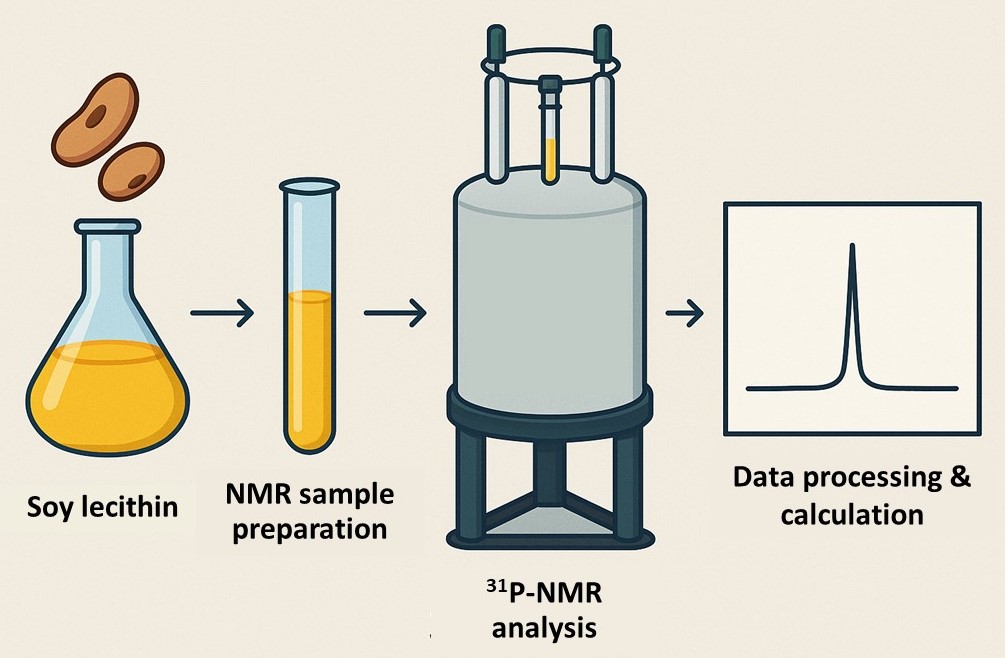Determination of Phospholipid in Lecithin from Soybean Using Phosphorous Nuclear Magnetic Resonance Spectroscopy
Keywords:
phospholipids , soy lecithin , 31P nuclear magnetic resonance spectroscopyAbstract
Background and Objectives : Soy lecithin is widely utilized in dietary supplements as well as in the formulation of food, pharmaceuticals, cosmetics, and animal feed. Its structure comprises several key phospholipids, including phosphatidylcholine (PC), phosphatidylethanolamine (PE), phosphatidylinositol (PI), phosphatidic acid (PA), and phosphatidylserine (PS), all of which play crucial roles in cellular growth, lipid transport, and the synthesis of neurotransmitters such as acetylcholine. Despite its numerous health benefits, excessive intake of lecithin may lead to adverse effects, including nausea, vomiting, loss of appetite, and excessive sweating. Therefore, accurate and precise analysis of the types and quantities of phospholipids in lecithin products is essential for quality control. Currently, high performance liquid chromatography (HPLC) and fourier transform infrared spectroscopy (FT-IR) are commonly employed for both qualitative and quantitative analysis of phospholipids. However, these techniques have certain limitations, such as reliance on reference standards specific to each analyte, dependence on specific stationary and mobile phases, long analysis times, and the generation of considerable chemical waste. To address these limitations, this study explores the application of phosphorous nuclear magnetic resonance spectroscopy (31P-NMR) for the analysis of phospholipids. This technique enables the simultaneous detection of multiple phospholipid species in a single analysis with high specificity, due to the distinct 31P signals characteristic of each phospholipid type. Therefore, the development and application of ³¹P-NMR as a method for identifying and quantifying phospholipids in soy lecithin presents a promising alternative, offering significant advantages over conventional methods and contributing to product safety and quality assurance for consumers.
Methodology : In the present study, a solvent system was formulated for the extraction of phospholipids from soybean lecithin using a mixture comprising 0.75 M Cs2CO3/EDTA (pH 8.5), deuterated chloroform, and a standard solution of triphenyl phosphate at a concentration of 6 mg/mL in methanol, in a volumetric ratio of 2:2:2. Soy lecithin samples (300 mg) were extracted at ambient temperature, and the organic layer was subsequently collected for analysis using 31P nuclear magnetic resonance spectroscopy (31P-NMR). Each sample was analyzed in triplicate to ensure reproducibility. The lecithin samples were categorized into four groups: (1) standard soybean lecithin, (2) commercially available encapsulated soybean lecithin, (3) chemically modified soybean lecithin and (4) lecithin extracted from dehulled soybean seeds. Analytical performance parameters, including the limit of detection (LOD) and limit of quantitation (LOQ), were determined using samples prepared in the same manner as those used for routine 31P-NMR analysis to ensure methodological reliability. To validate the NMR findings, complementary quantitative analysis of phospholipids was performed using high performance liquid chromatography (HPLC). A phosphatidylcholine (PC) standard solution was prepared at a concentration of 5 mg/mL and employed to construct a calibration curve within the range of 100–1250 µg/mL. Lecithin samples were accurately weighed, dissolved in methanol, subjected to ultrasonic-assisted dissolution and analyzed using a reverse-phase HPLC system. The mobile phase consisted of a mixture of isopropanol, water, and methanol in a ratio of 70:22:8. UV detection was carried out at a wavelength of 205 nm over a chromatographic run time of 30 minutes.
Main Results : This study focused on the development of a method for the identification and quantification of phospholipid components in soybean-derived lecithin. The investigation was conducted on four types of samples: (1) standard soybean lecithin, (2) lecithin extracted from dehulled soybean seeds, (3) encapsulated soybean lecithin used as dietary supplements, and (4) chemically modified soybean lecithin. The analysis revealed the presence of 11 phospholipid species across all lecithin samples: phosphatidylcholine (PC), 1-lysophosphatidylcholine (1-LPC), phosphatidylinositol (PI), 2-lysophosphatidylcholine (2-LPC), lysophosphatidy linositol (LPI), phosphatidylethanolamine (PE), diphosphatidylglycerol (DPG), lysophosphatidylethanolamine (LPE), phosphatidylglycerol (PG), phosphatidylserine (PS), and lysophosphatidic acid (LPA). However, the number and relative abundance of phospholipid species varied among the sample types: standard soybean lecithin contained 10 phospholipid species, lecithin from dehulled soybean seeds contained 7, the encapsulated lecithin supplement contained all 11, and the chemically modified lecithin also contained 11. Each phospholipid exhibited a distinct ³¹P-NMR signal with a chemical shift in the range of -0.77 to 3.8 ppm. Relaxation time (T1) measurements showed that phosphorous atoms in soybean lecithin phospholipids had T1 values not exceeding 2 seconds. In contrast, the internal standard, triphenyl phosphate, used for quantification, exhibited a T1 value of 5.65 seconds, longer than those of all other phospholipids. Making it suitable as a reference compound. The number of scans was set to 256, yielding a signal-to-noise ratio (S/N) of 3070. Under these conditions, the time required for quantification of each sample was approximately 46 minutes. The analytical limits obtained using the 31P-NMR technique included a limit of detection (LOD) of 0.01 mg/mL and a limit of quantification (LOQ) of 0.02 mg/mL.
Conclusions : This research successfully developed and evaluated the effectiveness of the 31P-NMR technique for the qualitative and quantitative analysis of phospholipids present in soy lecithin. The aim was to overcome the limitations associated with conventional analytical methods such as HPLC, TLC, and FTIR, which typically require specific reference materials, involve lengthy analytical procedures and generate considerable chemical waste. The analysis results demonstrated that the chemical shift positions of various phospholipid species across four sample groups were consistent and distinctly separable within the range of -0.77 to 3.80 ppm, making the technique suitable for both qualitative and quantitative analysis due to the structural differences among phospholipid types. Furthermore, the findings revealed that the 31P-NMR technique enabled the identification and quantification of up to eleven phospholipid species in a single run, with a total analysis time of only 46 minutes. This significantly reduced analysis time, minimized waste production, and eliminated the need for phospholipid-specific standards. Notably, the method also achieved a detection limit as low as 0.01 mg/mL.
References
Ahmmed, M. K., Carne, A., Stewart, I., Tian., H. S., & Ahmed Bekhit, A. E. (2021). Phosphorus-31 nuclear magnetic resonance (31P NMR) for quantitative measurements of phospholipids derived from natural products: Effect of analysis conditions. LWT-Food Science and Technology, 142, 110991. 1-8.
Bharti, K. S., & Roy, R. (2012). Quantitative 1H NMR spectroscopy. Trends in Analytical Chemistry, 35, 5-26.
Blusztajn, J. K., Liscovitch, M., & Richardson, U. I. (1987). Synthesis of acetylcholine from choline derived from phosphatidylcholine in a human neuronal cell line. Proceedings of the National Academy of Sciences, 84, 5474-5477.
Cooper, L., & Ainscough, T. (2016). FT-NIR analysis of lecithin. Inform, 27, 706–707.
Deranieh, R. M., Joshi, A. S., & Greenberg, M. L. (2013). Thin-Layer Chromatography of Phospholipids. Methods in Molecular Biology, 1033, 21-27.
Feringa, B. L., Smaardijk, A., & Wynberg, H. (1985). Simple 31P NMR method for the determination of enantiomeric purity of alcohols not requiring chiral auxiliary compounds. Journal of the American Chemical Society, 107, 4798-4799.
Glonek, T. (1998). 31P Nuclear magnetic resonance phospholipid analysis of anionic-enriched lecithins. Journal of the American Oil Chemists' Society, 75, 569-573.
Horn, M., Kadgien, M., Schnackerz, K., & Neubauer, S. (2000). 31P-nuclear magnetic resonance spectroscopy of blood: a species comparison. Journal of Cardiovascular Magnetic Resonance, 2(2), 143.
Hurst, W. J., & Martin, R. A. (1984). The analysis of phospholipids in soy lecithin by HPLC. Journal of the American Oil Chemists’ Society, 61(9), 1462–1463.
Jangle, R. D., Magar, V. P., & Thorat, B. N. (2013). Phosphatidylcholine and its purification from raw de-oiled soya lecithin. Separation and Purification Technology, 102, 187-195.
Kato, T., Nishimiya, M., Kawata, A., Kishida, K., Suzuri, K., Saito, M., Fujita, K., Igarashi, T., & Inagaki, M. (2018). Quantitative 31P NMR method for individual and concomitant determination of phospholipid classes
in polar lipid samples. Journal of Oleo Science, 67, 1279-1289.
Lanier, K. L., Moore, J. D., Smith, D., Li, S., Davis, B. ,& Shaw, W. A. (2008). Quantitative phospholipid analysis of soy lecithin and krill lecithin by 31P-NMR. Avanti Polar Lipids, Inc.
Liu, L., Waters, D. L. E., Rose, T. J., Bao, J., & King, G. J. (2013). Phospholipids in rice: Significance in grain quality and health benefits: A review. Food Chemistry, 139, 1133–1145.
Liu, Y., Gao, L., & Yu, Z. (2025). Quantitative 31P NMR spectroscopy: Principles, methodologies, and applications in phosphorus-containing compound analysis.
Meng, X., Pan, Q., Ding, Y., & Jiang, L. (2014). Rapid determination of phospholipid content of vegetable oils by FTIR spectroscopy combined with partial least-square regression. Food Chemistry, 147, 272-278.
Mertins, O., Sebben, M., Schneider, P. H., Pohlmann, A. R., & Silveira, N. P. (2008). Characterization of soybean phosphatidylcholine purity by 1H and 31P NMR. Química Nova, 31, 1856–1859.
Monakhova, Y. B., & Diehl, B. W. K. (2015). Quantitative analysis of sunflower lecithin adulteration with soy species by NMR spectroscopy and PLS regression. Journal of the American Oil Chemists' Society, 93, 27-36.
Scholfield, C. R. (1981). Composition of soybean lecithin. Journal of the American Oil Chemists’ Society, 58(10), 889–892. Applied Sciences, 15, 323.
Sousa, R. S., Nogueira, A. O. M., Marques, V. G., Clementin, R. M., & Lima, V. R. (2013). Effects of -eleostearic acid on asolectin liposomes dynamics: Relevance to its antioxidant activity. Bioorganic Chemistry, 51, 8-15.
Wu, Yingzi. (2002). Soybean lecithin composition, fractionation, and functionality. Iowa State University.
Zheng, A., Liu, S. B, & Deng, F. (2017). 31P NMR chemical shifts of phosphorus probes as reliable and practical acidity scales for solid and liquid catalysts. Chemical Reviews, 117, 12475-12531.

Downloads
Published
How to Cite
Issue
Section
License
Copyright (c) 2025 Faculty of Science, Burapha University

This work is licensed under a Creative Commons Attribution-NonCommercial-NoDerivatives 4.0 International License.
Burapha Science Journal is licensed under a Creative Commons Attribution-NonCommercial-NoDerivatives 4.0 International (CC BY-NC-ND 4.0) licence, unless otherwise stated. Please read our Policies page for more information


